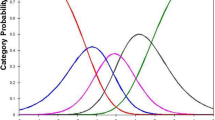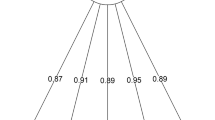Abstract
Anxiety is a common experience and component of the human condition, but as a construct it is difficult to define and anxiety scales vary in which aspects are emphasized. In the present study, we analyzed and quantified the content overlap of self-report instruments used to measure non-specific or global anxiety. Categorization of the 313 items across thirteen commonly used anxiety scales resulted in 60 disparate categories that spanned a wide variety of symptoms. Mean overlap between all of the selected scales was generally low. On average, only 30.9.% of all symptoms were captured by any given measure. Results indicate that the scales are heterogenous in the content that they measure. Therefore, anxiety-related scales should not be assumed to be interchangeable and careful consideration should be taken when selecting measures.

Similar content being viewed by others
References
American Psychiatric Association. (2013). Diagnostic and statistical manual of mental disorders: DSM-5TM (5th ed.) (2013-14907-000). Author; psyh. http://dist.lib.usu.edu/login?url=http://search.ebscohost.com/login.aspx?direct=true&db=psyh&AN=2013-14907-000&site=ehost-live
Antony, M. M. (2002). Assessment of anxiety and the anxiety disorders: an overview. In M. M. Antony, S. M. Orsillo, & L. Roemer (Eds.), Practitioner’s Guide to Empirically Based Measures of Anxiety (pp. 9–17). Kluwer Academic Publishers. https://doi.org/10.1007/0-306-47628-2_2
Antony, M. M., & Barlow, D. H. (Eds.). (2020). Handbook of assessment and treatment planning for psychological disorders (Third edition). The Guilford Press.
Antony, M. M., Orsillo, S. M., & Roemer, L. (2001). Practitioner’s guide to empirically based measures of anxiety. Springer Science & Business Media.
Aylett, E., Small, N., & Bower, P. (2018). Exercise in the treatment of clinical anxiety in general practice–a systematic review and meta-analysis. BMC Health Services Research, 18(1), 1–18.
Baxter, A., Vos, T., Scott, K., Ferrari, A., & Whiteford, H. (2014). The global burden of anxiety disorders in 2010. Psychological Medicine, 44(11), 2363.
Beck, A. T., Epstein, N., Brown, G., & Steer, R. A. (1988a). An inventory for measuring anxiety: Psychometric properties. Journal of Consulting and Clinical Psychology, 56(6), 893–897. https://doi.org/10.1037/0022-006X.56.6.893
Beck, A. T., Epstein, N., Brown, G., & Steer, R. A. (1988b). An inventory for measuring clinical anxiety: Psychometric properties. Journal of Consulting and Clinical Psychology, 56(6), 893–897. https://doi.org/10.1037/0022-006X.56.6.893
Chambless, D. L., Caputo, G. C., Bright, P., & Gallagher, R. (1984). Assessment of fear of fear in agoraphobics: the body sensations questionnaire and the agoraphobic cognitions questionnaire. Journal of Consulting and Clinical Psychology, 52(6), 1090–1097. https://doi.org/10.1037/0022-006X.52.6.1090
Chrobak, A. A., Siwek, M., Dudek, D., & Rybakowski, J. K. (2018). Content overlap analysis of 64 (hypo) mania symptoms among seven common rating scales. International Journal of Methods in Psychiatric Research, 27(3), e1737.
Costello, C. G. (1967). Costello Comrey depression and anxiety scales. Measures for Clinical Practice: Aa Sourcebook. 2nd, 2, 155–160.
Derogatis, L. R. (1994). SCL-90-R: Administration, scoring, and procedures manual. Minneapolis, MN: National Computer Systems.
Dowle, M., Srinivasan, A., Gorecki, J., Chirico, M., Stetsenko, P., Short, T., Lianoglou, S., Antonyan, E., Bonsch, M., & Parsonage, H. (2019). Package ‘data. Table.’ Extension of ‘data. Frame.
Dray, S., & Dufour, A.-B. (2007). The ade4 package: Implementing the duality diagram for ecologists. Journal of Statistical Software, 22(4), 1–20.
Elwood, L. S., Wolitzky-Taylor, K., & Olatunji, B. O. (2012). Measurement of anxious traits: a contemporary review and synthesis. Anxiety, Stress & Coping, 25(6), 647–666.
Endler, N. S., & Kocovski, N. L. (2001). State and trait anxiety revisited. Journal of Anxiety Disorders, 15(3), 231–245. https://doi.org/10.1016/S0887-6185(01)00060-3
Epskamp, S., Cramer, A. O., Waldorp, L. J., Schmittmann, V. D., & Borsboom, D. (2012). qgraph: Network visualizations of relationships in psychometric data. Journal of Statistical Software, 48(4), 1–18.
Evans, J. D. (1996). Straightforward statistics for the behavioral sciences. Brooks/Cole Pub. Co.
Firth, J., Torous, J., Nicholas, J., Carney, R., Rosenbaum, S., & Sarris, J. (2017). Can smartphone mental health interventions reduce symptoms of anxiety? A meta-analysis of randomized controlled trials. Journal of Affective Disorders, 218, 15–22.
Fried, E. I. (2017). The 52 symptoms of major depression: Lack of content overlap among seven common depression scales. Journal of Affective Disorders, 208, 191–197. https://doi.org/10.1016/j.jad.2016.10.019
Garnier, S., Ross, N., Rudis, B., Sciaini, M., & Scherer, C. (2018). viridis: Default color maps from ‘matplotlib.’ R Package Version 0.5, 1, 2018.
Julian, L. J. (2011). Measures of anxiety: State-Trait Anxiety Inventory (STAI), Beck Anxiety Inventory (BAI), and Hospital Anxiety and Depression Scale-Anxiety (HADS-A). Arthritis Care & Research, 63(S11), S467–S472. https://doi.org/10.1002/acr.20561
Kagan, J. (2009). Two Is Better Than One. 2.
Kenny, D. A. (2019). Enhancing validity in psychological research. American Psychologist, 74(9), 1018–1028. https://doi.org/10.1037/amp0000531
Liberati, A., Altman, D. G., Tetzlaff, J., Mulrow, C., Gotzsche, P. C., Ioannidis, J. P. A., Clarke, M., Devereaux, P. J., Kleijnen, J., & Moher, D. (2009). The PRISMA statement for reporting systematic reviews and meta-analyses of studies that evaluate healthcare interventions: Explanation and elaboration. BMJ, 339(jul21 1), b2700–b2700. https://doi.org/10.1136/bmj.b2700
Lovibond, S. H., & Lovibond, P. F. (1996). Manual for the depression anxiety stress scales. Psychology Foundation of Australia.
Mokkink, L. B., Terwee, C. B., Patrick, D. L., Alonso, J., Stratford, P. W., Knol, D. L., Bouter, L. M., & de Vet, H. C. W. (2010). The COSMIN checklist for assessing the methodological quality of studies on measurement properties of health status measurement instruments: an international Delphi study. Quality of Life Research, 19(4), 539–549. https://doi.org/10.1007/s11136-010-9606-8
Newson, J. J., Hunter, D., & Thiagarajan, T. C. (2020). The heterogeneity of mental health assessment. Frontiers in Psychiatry, 11, 76. https://doi.org/10.3389/fpsyt.2020.00076
R Core Team. (2015). R: A language and environment for statistical computing. R Foundation for Statistical Computing. https://www.R-project.org/
Ree, M. J., MacLeod, C., French, D., & Locke, V. (2000). State-trait inventory for cognitive and somatic anxiety (STICSA). The University of Western Australia.
Revelle, W. (2017). psych: Procedures for personality and psychological research. https://CRAN.R-project.org/package=psych
Santor, D. A., Gregus, M., & Welch, A. (2006). FOCUS ARTICLE: Eight decades of measurement in depression. Measurement: Interdisciplinary Research & Perspective, 4(3), 135–155. https://doi.org/10.1207/s15366359mea0403_1
Saviola, F., Pappaianni, E., Monti, A., Grecucci, A., Jovicich, J., & De Pisapia, N. (2020). Trait and state anxiety are mapped differently in the human brain. Scientific Reports, 10(1), 11112. https://doi.org/10.1038/s41598-020-68008-z
Snaith, R. P., Baugh, S. J., Clayden, A. D., Husain, A., & Sipple, M. A. (1982). The clinical anxiety scale: an instrument derived from the Hamilton anxiety scale. The British Journal of Psychiatry, 141(5), 518–523.
Spielberger, C. D. (1983). Manual for the State-Trait Anxiety Inventory STAI (form Y)(“ self-evaluation questionnaire”).
Taylor, J. A. (1953). Manifest anxiety scale. American Psychological Association Washington, DC.
Terluin, B., Rhenen, W. V., Schaufeli, W. B., & De Haan, M. (2004). The Four-Dimensional Symptom Questionnaire (4DSQ): Measuring distress and other mental health problems in a working population. Work & Stress, 18(3), 187–207.
Visontay, R., Sunderland, M., Grisham, J., & Slade, T. (2019). Content overlap between youth OCD scales: Heterogeneity among symptoms probed and implications. Journal of Obsessive-Compulsive and Related Disorders, 21, 6–12. https://doi.org/10.1016/j.jocrd.2018.10.005
Watson, D., & Clark, L. A. (1991). The mood and anxiety symptom questionnaire (MASQ). Unpublished Manuscript, University of Iowa, Iowa City.
Wickham, H. (2007). Reshaping data with the reshape package. Journal of Statistical Software, 21(12), 1–20.
Wickham, H. (2009). ggplot2: Elegant graphics for data analysis. Springer-Verlag.
Wittchen, H.-U. (2002). Generalized anxiety disorder: Prevalence, burden, and cost to society. Depression and Anxiety, 16(4), 162–171. https://doi.org/10.1002/da.10065
Zigmond, A. S., & Snaith, R. P. (1983). The hospital anxiety and depression scale. Acta Psychiatrica Scandinavica, 67(6), 361–370.
Zung, W. (1971). Zung Self-Rating Anxiety Scale (SAS).
Acknowledgements
We would like to thank Eiko Fried for openly sharing his code and data and for so kindly helping troubleshoot our code.
Funding
This research did not receive any specific grant from funding agencies in the public, commercial, or not-for-profit sectors.
Author information
Authors and Affiliations
Corresponding author
Ethics declarations
Conflict of Interest
Andy D. Wall and Eric B. Lee declare that they have no conflict of interest.
Experiment Participants
No human participants or animals were involved in this research.
Additional information
Publisher's Note
Springer Nature remains neutral with regard to jurisdictional claims in published maps and institutional affiliations.
Supplementary Information
Below is the link to the electronic supplementary material.
Rights and permissions
About this article
Cite this article
Wall, A.D., Lee, E.B. What do Anxiety Scales Really Measure? An Item Content Analysis of Self-Report Measures of Anxiety. J Psychopathol Behav Assess 44, 1148–1157 (2022). https://doi.org/10.1007/s10862-022-09973-9
Accepted:
Published:
Issue Date:
DOI: https://doi.org/10.1007/s10862-022-09973-9




